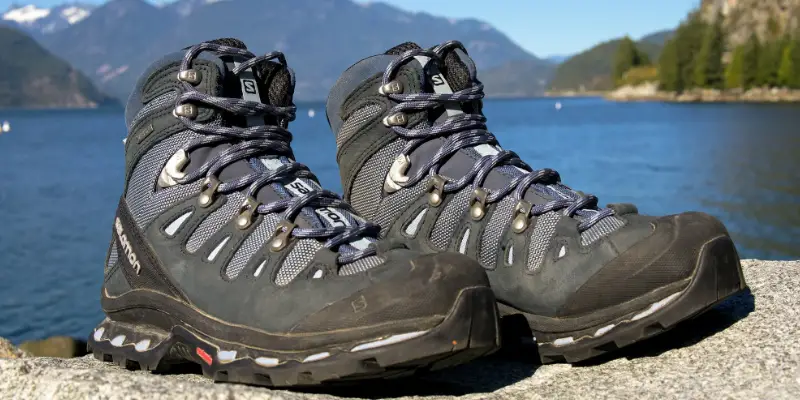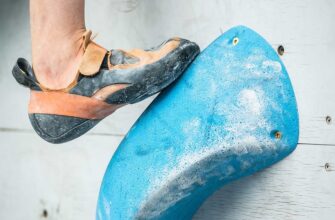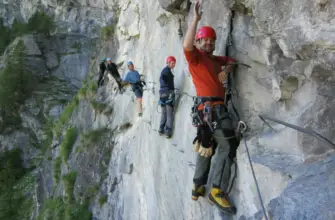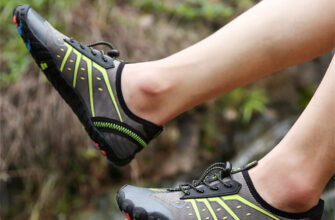The modern tendency of an active and healthy lifestyle has led to the fact that today many people choose mountain climbing as their destination. This is a real adventure that can be rather challenging and it helps to feel a connection with nature. You can find yourself in hiking, trail running, rock climbing, and so on.

It’s out of the discussion that you need the appropriate equipment of good quality for such an activity. And it’s rather important to choose a suitable pair of footwear. However, there are many options to choose from and sometimes people can’t decide whether to buy hiking shoes or approach shoes, or maybe trail runners.
So to make it easier for you we will compare approach shoes vs hiking shoes and also describe some other kinds of hiking footwear so that you’ll know which pair of shoes to choose for your climbing adventure. Keep reading.
- Types of hiking footwear
- Trail runners
- Hiking shoes
- Hybrid hiking shoes/Trail running shoes
- Approach shoes
- Climbing shoes
- Approach shoes vs hiking shoes
- Usage
- Weight
- Grip
- Durability
- Materials and design
- Comfort
- Waterproofness
- Approach shoes vs hiking shoes. How to choose what to buy?
- FAQ
- What is the difference between hiking and approach shoes?
- What is the point of approach shoes?
- Can you use approach shoes for climbing?
- Can I wear Asics for hiking?
- To draw the point. Approach shoes vs hiking shoes
Types of hiking footwear
First of all, we will briefly describe different types of hiking boots. The main difference among them is that they are all designed for different purposes which is why there are some dissimilarities in grip design, durability, weight, stiffness, materials, and waterproofness.
Trail runners
Trail runners are the type of footwear designed for trail running. They give light and bouncy motion but at the same time, they provide extra protection, support, and grip and traction you need for off-road activities.

As you see such qualities allow trail runners to be used not only by professional runners. They are very good for fast and light traveling. So today they are widely used by thru-hikers and even everyday hikers.
Some trail runners are meant only for running, but mostly they are developed for fast-and-light hiking.
What differentiates it from standard running shoes is that trail runners go with stiffer soles, heavy cushioning, and sturdier toe caps (still less than in a hiking shoe). And there are also waterproof versions available.
Hiking shoes
This is a modern style of hiking boots with a lower cut at the ankle. Actually, they provide the same stiffness and under feet support as traditional hiking boots, but they are not as bulky and clumsy. Due to their durable construction (usually made of leather or nylon) hiking shoe offers effective protection from different obstacles.

Most hiking shoes are hard to wear. They have soles equipped with a good grip which makes them indispensable if you need to overcome a slippery terrain. Moreover, they have a reinforced toe cap to protect your fingers from getting hurt.
We may say that a hiking shoe is somewhere in between a trail runner and a traditional hiking boot. Of course, it is heavier than trail runners but a hiking shoe is more durable and provides better protection. But it is still lighter than a traditional hiking boot.
However, due to a lower cut at the ankle hiking shoes don’t provide effective ankle support. So if you are looking for this, especially if you are a beginner, you should consider some other options.
There is a huge diversity of hiking shoes nowadays. They differ in stiffness and weight, some are more rugged, and others are more flexible.
Choosing hiking shoes, pay attention to such features as wide toe caps, thick soles sharp lugs for traction, and medium-stiff midsoles which protect from rugged terrain. Hiking shoes can be water-resistant as well.
Hybrid hiking shoes/Trail running shoes
To be honest, this type of hiking boots is not as good as the previous ones. It takes some characteristics of hiking shoes and trail runners, but in terms of quality and efficiency loses to both.

However, they combine such qualities as breathability, support, and low weight, which makes them suitable for light sport walking and thru-hiking.
The hybrid shoe was actually designed for situations when you have to carry heavy loads across rocky terrain to reach the climbing destination.
Approach shoes
These are shoes are to be worn when you want to approach your climbing destination, but the way to it is too rough. Many approach shoes can also be useful in long hikes and backpacking expeditions.
You might think it’s pretty weird to have a separate pair of shoes just to reach your climbing route. However, you can use them not only in that way. Some people take advantage of them in such activities as hiking, light scrambling, and low-level alpine climbing as well.

Climbers are likely to give their preference to approach shoe rather than hiking shoe or climbing shoe on easy rocks because they are able to protect your feet properly but won’t give them this unpleasant feeling of massiveness and clumsiness.
Approach shoes are more stable and provide greater durability than running shoes. Moreover, they can handle different terrains such as flat trails, scree slopes, and even technical terrain. They are not massive and due to a lower cut than we have in hiking boots, they provide better agility.
Approach shoes are equipped with a lugged rubber sole which offers excellent traction on different surfaces and provides you with greater grip. Approach shoe is made of synthetic materials and has a rubber rand in order to protect the shoe from attrition.
They use almost the same sticky rubber as there is in climbing shoes, but provide more security on the rock, while hiking shoes are more prone to slip and skid in this situation.
If you are likely to carry a light load while overcoming long distances approach shoes are the best option for you. However, sometimes it is not recommended to wear them for long routes, because they are quite tight, which is good for extra safety while climbing the rock but can lead your feet to swell.
Many approach shoes are equipped with the necessary amount of rigidity across the sole so that they are really helpful for edging on small rock footholds, but actually, they vary considerably.
Climbing shoes
Climbing shoes are used for rock climbing. They are more massive than hiking shoes and have some other features to make them more protective. To add it is better to use them for ascending vertical walls.

Climbing shoes are made from synthetic or leather uppers (which means the upper is quite thin) and involve harder rubber compounds. Moreover, the climbing shoe is equipped with an acuminate toe box to wrap securely around your feet, like a sticky second skin which provides precision and grip during climbing.

They are pretty tight, so you won’t like to use them for everyday hiking or fast-and-light traveling. But it helps to Place your feet accurately when climbing difficult routes or bouldering problems which is very essential.
Approach shoes vs hiking shoes
Now that you’ve learned about different types of hiking footwear let’s return to the main topic and compare hiking shoe with approach shoe.

Usage
As we have already mentioned approach shoes and hiking shoes are designed for different purposes. Approach shoes are used for walking and approaching climbing destinations when the way to them is rather rough, and hiking shoes are heavier and have a good grip for rough terrain.
But some climbers like to use approach shoes instead of hiking shoes in situations when they have to carry heavy loads or just when they want to feel more comfortable.
Weight
Actually, the lightest shoes are trail running shoes. But if we make a comparison between approach shoes and hiking shoes, approach shoes definitely win this category. By choosing lighter shoes you protect your feet from the need to carry heavy weight.

Grip
When you deal with rock surfaces it is much better to use approach shoes, because they have rather sticky rubber and less aggressive lugs that allow you to get more rubber on the rock. And more rubber means more grip.

However, hiking shoes are more suitable for muddy trails as they have soles with deeper lugs specially designed for these purposes.
Durability
Hiking shoes have harder rubber compounds in comparison with approach shoes which is why they’ll serve you longer. As well as trail running shoe, approach shoe has a softer rubber compound. But it must be said that there are approach shoes that can be resolved.

Materials and design
Well, an approach shoe has a lugged sole which is designed for different surfaces. And a hiking shoe has a sticky rubber sole. The stiffer sole makes them more suitable for climbing.

The uppers are also designed in a different way. Hiking shoes have thinner upper material which allows the foot to wrap around the shoe to provide a precise fit with minimal layers of construction. Approach shoe uses denser material for the uppers which makes them more resistant to abrasion.

The materials are different because shoes have different usages. Approach shoes must deal with rocky terrain but they still must be comfortable to climb in. For these matters, they have a combination of leather, rubber, and synthetic fabrics in their compound.
Comfort
We must admit that even though shoes have different weights and are designed for different purposes they all must be comfortable. If your feet don’t feel comfortable in it, you won’t wear it for a long time.

Approach shoes are designed so that you can walk in them all day without getting sore feet. Hiking shoes are more productive their snug fit and minimal layers of construction make it easier to feel your footholds and make precise foot placements.
Waterproofness
Approach shoes and hiking shoes are available in both waterproof and nonwaterproof versions. The shoes are only waterproof if they have waterproof linings like Gore Tex. You’ll see that hiking shoes go with waterproof membrane more often because rock climb is possible only when the weather is fine.
Approach shoes vs hiking shoes. How to choose what to buy?
So now it’s time to choose which pair of outdoor footwear to choose. As you may see all footwear is designed for particular purposes and will be useful in different situations.
Speaking about approach shoes, comfort is actually a primary consideration.

Approach shoes are rather comfortable so some use them as a more appropriate type of hiking boot. If you are fond of hiking you are recommended to take advantage of approach shoes as they provide extra security on more technical ground.
If you are looking for more ankle support than a low-cut approach shoe provides you should try to find a mid-cut alternative.
Approach shoes are also very helpful for hikes with peak bagging or ridge traverses. But if you spend a lot of time on typical hiking terrains and need the best combination of comfort, protection, support, and durability you’d better look for hiking shoes.

Also, think about these factors: massive hiking boot won’t do you any good if you’ll wear them for every hike. So wearing lightweight shoes will give your feet an appropriate load so that you are less likely to get injured. Moreover, if you carry light loads you are recommended to choose the approach shoes because they have a great combination of flexibility, cushion, and nimbleness.
Many approach shoes have much stickier rubber in order to provide more grip. So we may say that approach shoes are more suitable for approaching rock climbs and they are less effective when they face mud, snow, and dusty trails. Tackling technical climbs is easier with approach shoes as well.
Approach shoes are also not very good for average hiking. Their stiff soles are not comfortable to wear for such activity. In this case, it’s better to choose from trail runners, hiking shoes, or climbing shoes.
To add approach shoes are not capable of keeping your feet warm. So they are useless when you reach the snow line.

Most hiking shoes still offer good grip, but the lugs on the soles are deeper, which makes them good for slippery terrain. Usually, they are equipped with reinforced toe box which protects your pinkies.
So the best idea is to have both hiking shoes and approach shoes.
FAQ
What is the difference between hiking and approach shoes?
Comparing approach shoes vs hiking shoes we may say that they are designed for different purposes.
Approach shoes are to be worn when you want to approach your climbing destination, but the way to it is too rough or when you deal with technical terrain. They may be used for hiking as well. For example, you are more likely to see rock climbers wearing approach shoes when they carry huge bags rather than more massive hiking shoes or climbing shoes.
And hiking shoes are more durable and can be used for overcoming snow lines, muddy and dusty terrains.
What is the point of approach shoes?
The main usage of approach shoes is to get to your hiking destination without any difficulties. However, they have wider usage and it’s a good idea to have them if you are a regular rock climber.
Can you use approach shoes for climbing?
These shoes are actually versatile and can be used in different activities such as hiking, light scrambling, and low-level alpine climbing as well.
Can I wear Asics for hiking?
Yes, you can. These are excellent, durable shoes, which are also good for walking and hiking.
To draw the point. Approach shoes vs hiking shoes
There are several factors you should take into account while choosing approach shoes vs hiking shoes, or sometimes you select from trail shoes, climbing shoes, hybrid shoes, and trail runners.
You need to choose footwear according to your intentions towards it. If you are fond of rock climbing it will be very useful for you to have approach shoes for extra comfort, because sometimes approaching the rock climbs can get complicated due to steep and rocky trails.
If you are more into average hiking then you, of course, need hiking shoes, which are specially designed for this purpose.
If you are trying to find a good approach shoe brands we recommend you to check out La Sportiva Boulder X. It offers durable, comfy shoes with sticky rubber for a reasonable amount of money.
La Sportiva Boulder X will perform well on dangerous trails, but at the same time won’t bring you any discomfort. They use a beefy rubber rand which wraps and protects your feet and leather is used as the upper material.
For trail running, you’ll need a pair of trail runners. A trail running shoe gives light and bouncy motion and they provide extra protection, support, and grip you need for off-road activities. However, trail runners perform their best on well maintained trails. Read about how to stretch out climbing shoes










